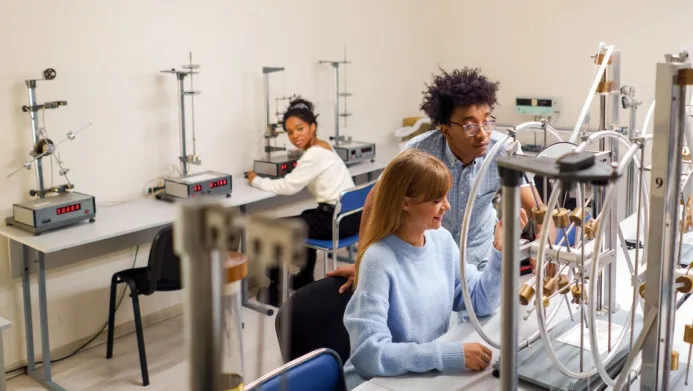Education is an age-old industry. Traditionally, it has relied on the time-honored, face-to-face, classroom learning experience. With the advent of Web technologies, the industry has been disrupted as courses can now be created and delivered online to a global virtual audience.
Education is an age-old industry. Traditionally, it has relied on the time-honored, face-to-face, classroom learning experience. With the advent of Web technologies, the industry has been disrupted as courses can now be created and delivered online to a global virtual audience.
Education under the New Normal
According to UNESCO, at the peak of COVID-19 around April 2020, approximately 1.3 billion, or 82% of the world's enrolled students, were out of school due to school closures. As the world grappled with COVID-19, online education was no longer just a social experiment; in some places, it became the only game in town.
The COVID pandemic provided the education industry with many valuable lessons:
Global Adoption
At the 3rd World Higher Education Conference in May 2022, Prof. Asha Kanwar noted a silver lining in the pandemic: the global acceptance of online learning. UNICEF recommends multiple learning channels during emergencies, emphasizing digital access to reduce vulnerability. Integrating technology into the traditional classroom also enriches student learning during regular times.
Inclusivity
School closures exacerbated the issues faced by disadvantaged learners. An inclusive education system provides extra support services needed by disadvantaged learners facing educational inequalities due to factors relating to gender, disability, learning difficulties, or other sources of socioeconomic disadvantages. COVID-induced school closures entailed that learners with special needs had to be educated at home without the support services normally offered in schools. This resulted in severe disadvantages to the special-need learners and their families during COVID.
Learning motivation
Home-based learning during COVID-19 highlighted student motivation and engagement. Authentic learning that allows students to apply knowledge to everyday life is critical to student engagement. The OECD advocated significant changes in the classroom, emphasizing extended learning and teacher support.
Self-directed learning is consistent with a focus on learners and real-world situations and is gaining recognition, especially in higher education. Students set and regulate their goals, making learning more engaging and relevant to their interests and challenges.

Personalized scaffolding
While self-directed learning is generally credited for increasing students' motivation to learn, it undeniably puts additional cognitive demands on them beyond those required to learn the subject matter at hand. To mitigate the risk of overloading self-directed students, educational research has been done on ‘scaffolding’ which involves providing assistance to students on an as-needed basis, fading the assistance as their competence grows. Personalized scaffolding is an active research area on automatically generating scaffolds, including learning goals, that are personalized for individual learners.
Outdoor learning
During COVID, schools that remained open mitigated the risk of virus transmission by reducing class sizes and spacing out student desks. Reports indicated that some schools, including those in higher education, adapted by offering classes in outdoor settings. Besides lowering the health risk, outdoor classes offer interesting possibilities in institutional space management. Yet, it opens up new challenges in that outdoor classes will hasten the support of new technologies. It remains to be seen whether outdoor classes will become permanent fixtures in the education landscape.

Teacher training
Dr. Tony Mays emphasized the need for ongoing, hands-on professional development for teachers during the transition to sustainable online and distance learning. UNICEF's research across 127 countries reflected this concern, indicating a lack of support for teachers in using technology for online instruction during COVID-19. UNICEF recommended that professional development focus on virtual classroom management improved online presentation techniques, and effective integration of technology into the classroom.
In addition to formal teacher training, mentoring is recognized as an effective way to support teachers' professional development.
Expanded role of parents and siblings
COVID school closures mean that students learn at home without the usual learning support provided by schools. In many cases, the role of parents and siblings expanded under home-based remote education to include varied levels of active tutoring and supervision.
Data Privacy
The move to a decentralized learning environment during school closures resulted necessarily in more data, private and personal, residing in out-of-school locations. France’s Education Minister Jean-Michel Blanquer raised the need for appropriate regulation of online educational institutions to 'ensure adherence to rules on the collection, management, and use of data, especially the personal data of children and youth'.
Capturing feedback
COVID prompted an unprecedented shift to remote learning globally. Now, transitioning from pandemic to endemic, the education sector must assess what worked and what needs improvement. UNICEF recommends focused research to enhance teacher training, content production, parental engagement, and scalable tech use. This insight will aid future pandemic preparedness and optimize blended learning.
Is Drupal a good CMS for High Education?
Global acceptance of online learning has become an established fact during the pandemic. A critical component of an online learning platform is the CMS. According to a 2020 study, the top two CMSs used by US universities and colleges were WordPress and Drupal, making up 40% and 19% respectively of the institutions surveyed. Larger institutions (as measured by student enrollment) favored Drupal over WordPress. Stanford, MIT, and every Ivy League school used Drupal.

Below, we discuss various factors that affect how Drupal fares as an education CMS under the post-COVID new normal.
Rich digital experience

The key to improving learners' motivation in online learning is to provide them with a rich digital experience. Can Drupal provide a complex enough learning experience for learners to keep them engaged?
Enhancing learner motivation in online education requires a rich digital experience. Drupal is evolving into a Digital Experience Platform (DXP), prioritizing personalization based on data analytics for unique user experiences, and aligning with self-directed learning trends.
Drupal is able to integrate an ever-growing list of functionalities—digital asset management, social media integration, chatbots, forums, calendars, e-commerce—onto its platform, making it an engaging online learning environment.
Its modular architecture allows seamless addition of user experience modules.
Extensibility
Drupal's robust core, easily extended with third-party modules, ensures future-proofing by incorporating innovative applications such as AI, machine learning, and Blockchains. Leveraging community-supported learning applications is critical. Opigno, a Drupal-based LMS, seamlessly integrates modules for e-commerce, CRM, video conferencing, and more. Geogebra, another Drupal-based platform, enhances math education with interactive geometry lessons and a huge repository of free math resources.
Distance learning expands learning locations and participants, requiring accessibility on multiple devices. Drupal's flexibility allows seamless extensions for mobile devices, IoT devices, and digital signage.
Security

The Drupal community has a dedicated security team that pounces on any discovered vulnerabilities in order to release timely security updates. To further enhance security, third-party security modules are available to install on Drupal websites. Drupal’s heightened security awareness provides better protection of students’ personal data in remote learning.
Accessibility

Drupal prides itself on being an inclusive community and has built-in accessibility support since 2011. An ongoing goal of Drupal is to ensure that all features of the Drupal core conform with federal accessibility regulations and guidelines. Accessibility-compliant websites enable physically challenged students to participate fully in online classroom activities in ways that are on par with those not living with a disability.
Supportive open-source community

It is no secret that, for open-source projects, strong community support ensures regular software updates and ongoing feature innovation. Besides software benefits, a strong community generates user benefits from peer collaboration and support. There are many existing Drupal groups that are dedicated to promoting the use of Drupal for education websites. If you can't find an existing group to join that suits your particular needs, the Drupal community makes it really easy to start one yourself. As noted above, the roles of teachers, parents, and siblings have expanded in digital learning. A supportive special-purpose community can provide the needed training and mentoring for them to fulfill their expanded roles.
The lower total cost of ownership
Drupal is free and open source: anyone can use and change the software without paying a license fee. The caveat is that institutions lacking in-house I.T. resources need to outsource the work related to software customization and installation of major updates. Free community resources such as support forums, online training, and third-party modules also contribute to the lowering of the overall cost of ownership of Drupal. The savings generated can be allocated back to improve the quality of online education in other areas.
Summary & conclusion
Drupal is a good CMS for educational institutions. It is no coincidence that 71% of the top 100 universities in the US use Drupal. A Drupal-based educational website gives students and staff the rich digital experience they expect from a modern online presence, all in a secure and accessible environment. Plus, there are no licensing costs associated with using Drupal. With IT budgets under pressure, spending the money saved on improving the curriculum is a welcome change.
Five Jars has extensive experience building Drupal sites for a variety of industries, including education. We understand the digital challenges facing educational institutions in the post-COVID era. Contact us today for a start on your digital transformation journey.



